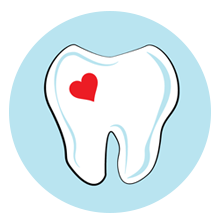Restorative DENTISTRY
Bridges
If you’ve lost teeth due to accident, injury or gum disease, your dentist can create a permanent bridge to restore your solid smile.
A bridge not only fills the gap, but it also prevents repositioning of remaining teeth. It can also correct a misaligned bite, improve chewing function and speech articulation, and provide internal structure for the face to give you a more youthful appearance.
What is a Fixed Bridge?
A bridge is a prosthetic tooth that attaches on one or both sides to teeth prepared with dental crowns.
A fixed bridge is permanently joined onto the neighboring abutment teeth (crowned teeth) and consists of three basic units: the false tooth or teeth (called a pontic) and two abutment crowns.
The style of bridge you need will depend upon the strength and health of the abutment teeth, as well as the location of the gap in relation to the rest of your dentition.
If healthy adjacent abutment teeth aren’t available, a surgically-implanted metal post, known as a dental implant, may offer a solid alternative.
For a bridge that replaces many teeth, you may be recommended a removable partial denture or implant-supported prosthesis.
With proper care, a fixed bridge may last at least 8 to 10 years.
Composite Fillings
If you’re embarrassed about your smile because of decay or dark fillings in your teeth, you may be a good candidate for composite resins.
Because composite resins are not made of metal, your doctor can blend and mix shades to find the perfect color to match your natural teeth. This means only you and your dentist will know you have fillings. Another benefit is that the tooth/composite bond actually supports the remaining tooth structure, deterring breakage and insulating against temperature changes. Medium and small composites can last seven to ten years: as long as the best of metal amalgam fillings. Best of all, composite resins allow more of your natural tooth structure to remain intact than when using amalgam fillings.
Some patients experience mild and temporary post-placement sensitivity from composite resin fillings. Please also be cautioned that coffee, tea, and other staining foods and beverages may discolor your composites unless you ask to have them coated with a clear plastic sealant.
Crowns
A crown can return structure, strength, and appearance to a tooth with extensive decay or damage. Designed to fit snugly and function as a healthy tooth, a crown will protect your tooth from further damage and preserve the jaw’s correct natural alignment.
Crowns are typically placed for patients whose teeth have been broken or severely damaged by decay to the point where a filling cannot replace enough of the tooth or make the tooth strong enough.
Depending on your specific situation, the doctor may propose a precious metal, porcelain pressed (or fused) to metal or an all-porcelain crown. Precise color-matching system allows your dentist to find the right shade of porcelain to blend with your natural tooth color. Porcelain crowns are extremely durable and long lasting – benefits which make them popular with dentists and patients alike.
It typically takes only a couple of short appointments to design, fit and place a crown. Once a crown is placed, you take care of it the same way you care for your natural teeth. Brushing twice a day and daily flossing will protect the base of your crown from bacterial growth. Be sure to see your dentist at least twice a year for professional cleanings and preventive exams.
Dentures and Partials
A smile just isn’t a smile if it’s incomplete. Missing teeth cause a host of problems, from difficulty speaking and eating to low self-confidence to jawbone deterioration.
Don’t give up on your smile. Advances in dental materials and technology have made full and partial dentures more lifelike and comfortable than ever.
Depending on how many natural teeth you still have, your doctor may recommend a complete (full) or partial denture.
- Partial dentures are used to fill in the space created by missing teeth to fill out your smile.
- Complete dentures are used to completely replace all teeth.
If you prefer a secure full or partial denture, and do not want clips or adhesive, then consider implant-supported dentures.
In a brief surgery, an implant dentist can secure a few dental implant posts to hold your dentures in place. With implant-supported dentures, you won’t have to worry about slippage, and your prosthetic will feel safe and sound.
Now that I have dentures, do I still need to visit a dentist?
Regular appointments with the dentist are as important for denture-wearers as for people with natural teeth. The mouth tissue, bony ridges and gums that support dentures are constantly undergoing changes and may impair the denture’s proper function.
Even such general health ailments as vitamin deficiencies, extended illness, drug therapy, weight loss, diabetes or high blood pressure can change the way dentures fit.
Ill-fitting dentures can seriously damage the mouth, causing abrasions, bruises, inflammation and rapid destruction of the supporting bone. Prolonged irritation of this kind may result in the development of tumors.
It is important to have a dental checkup at least once a year to insure that your dentures are properly adjusted and that your mouth is in good health.
Root Canals
A root canal is something that we don’t mind as long as it happens to someone else. Root canal therapy has existed for centuries and actually was first performed in ancient civilizations – although most often only the nobility and the very wealthy were treated.
Root canal treatment is used to save teeth which would otherwise need to be removed.
It is needed when the blood or nerve supply of the tooth (known as the pulp) is infected through decay or injury.
Sometimes, due to trauma or decay the “nerve” inside the tooth dies off (please do not confuse that with your “tooth” being dead, that is simply not true!). Any passing bacteria find this a source of nourishment and proceed to munch on the dead nerve and quickly reproduce. Your body can’t do anything about this infection because along with the nerve dying, the blood supply to the tooth dies off too, so the body can’t send in some antibacterial cells (white blood cells) to attack the bacteria. Eventually, the bacteria start to spill out of the tooth and into the tiny space between the tooth and the jawbone. This starts an abscess, the body reacts to the invasion by pouring in defensive cells, which kill most of the bugs in the area, but still can’t get to the source of the problem, which is in the tooth.
Some indications for a root canal are:
- Pain while biting
- Sensitivity to hot or cold
- Deep decay
- Blunt injury to the tooth
- Infection
What is root canal therapy?
Your dentist will thoroughly examine your tooth to determine if the nerve is infected. The exam includes x-rays and checking the health of the tooth with a pulp tester. Additionally your doctor may also apply cold and heat, tap on the tooth to see if sensitive or press gently on gums around tooth to check for pain.
The treatment can take from one to three visits during which typical treatment involves:
- Making an opening through the crown of the tooth and into the pulp chamber
- Removing the pulp. The root canal is cleaned, enlarged and shaped to a form that can be filled.
- (Optionally) Placing medication into the pulp chamber and root canal to help get rid of any germs and prevent infection.
- Placing a temporary filling in the crown opening to protect the tooth before your next visit. Alternatively, your doctor may leave the tooth open for a few days to drain.
- Filling and sealing the pulp chamber and root canals.
- Removing the temporary filling, followed by cleaning and filling of the pulp chamber.
- And finally, placing a gold or porcelain crown over the tooth.
Tooth Extractions
A tooth extraction may be recommended by your dentist for several reasons in order to maintain the overall health of your mouth.
Some of these reasons may be:
- A crowded mouth – Teeth may need to be extracted in order to prepare the mouth for braces or to make room for teeth that are trying to break through the gums.
- Infection – A tooth may need to be extracted if tooth decay has reached to the pulp, which is the center of the tooth that contains the nerves and blood vessels. Extraction will help prevent the further spread of tooth decay.
- Risk of infection – Finally, a tooth may need to be extracted if you have a low immune system from chemotherapy or an organ transplant. The risk of infection may be worth extracting the tooth in order to prevent it from spreading.
Your dentist will numb the area where your tooth is in order to lessen the discomfort from the extraction. You will need to rinse your mouth gently for several days after the extraction and apply ice to areas that are affected by swelling.

